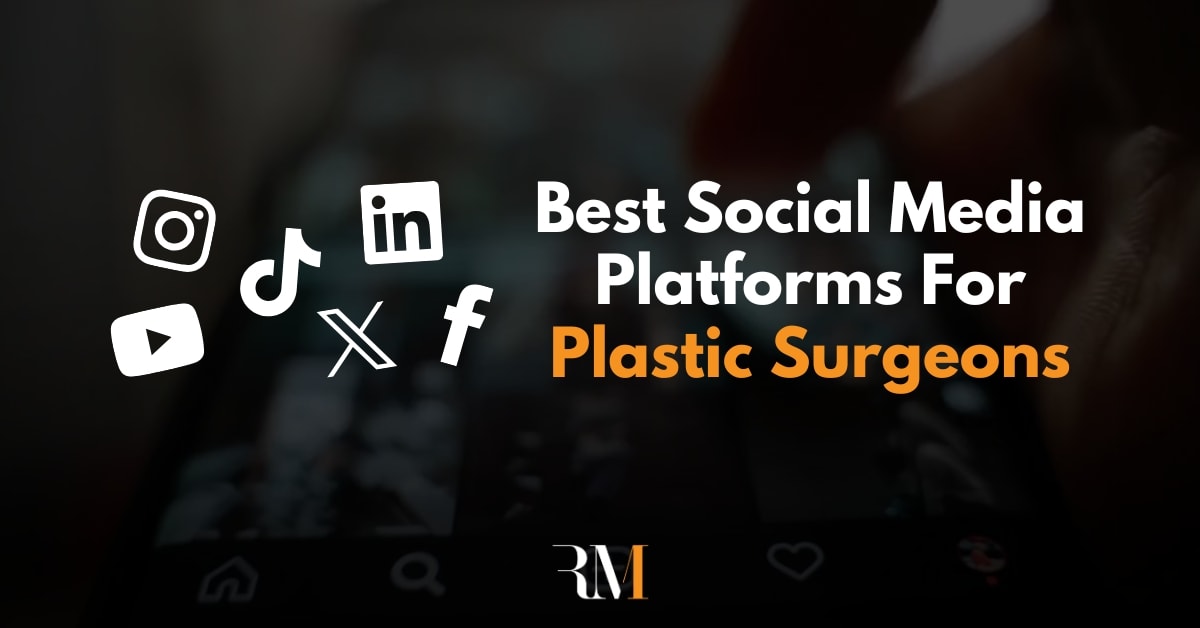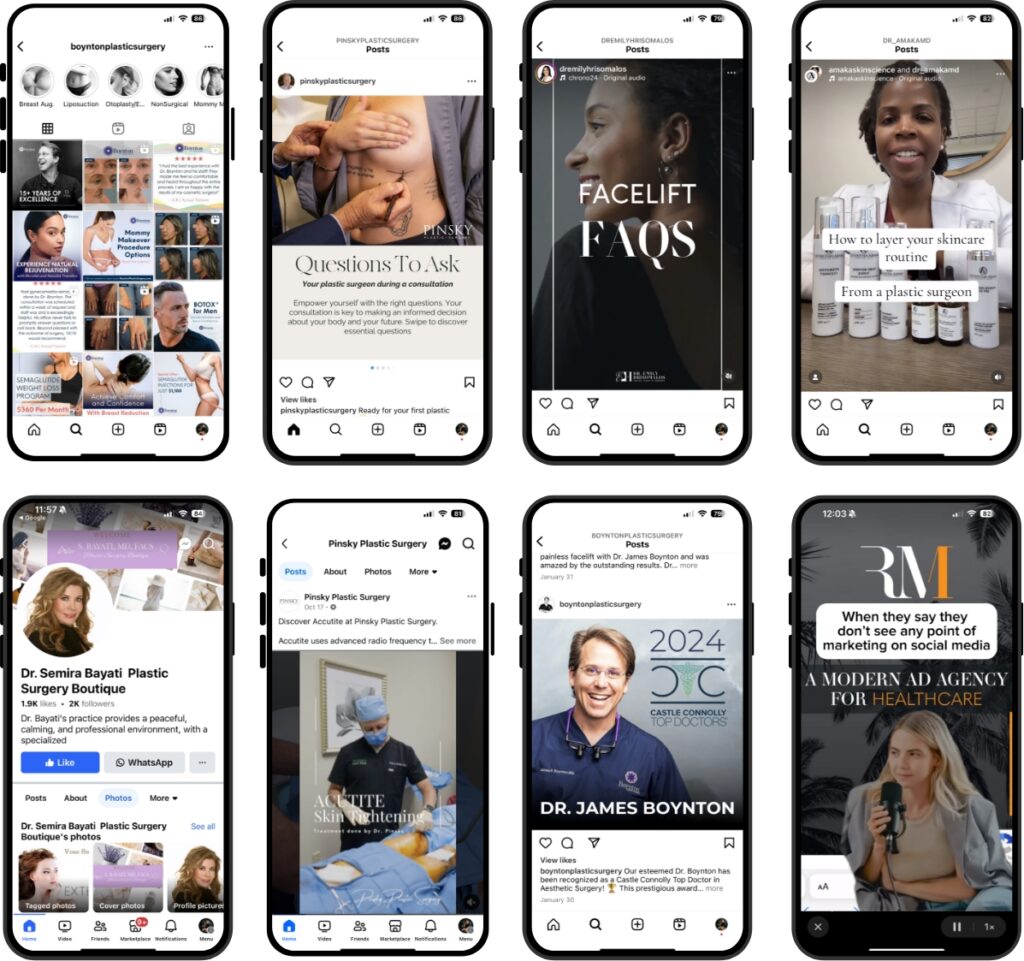Best Social Media Platforms for Plastic Surgeons

Social media plays a key role in many of our social and interpersonal lives, but the ways in which some of the most popular platforms have become integral to our business needs as well can be a little surprising. According to the American Society of Plastic Surgeons (ASPS), major search engines like Google are even promoting searches based on social media presence to a greater degree than other factors, such as training, memberships, or educational background. Educational plastic surgery content has always performed well on social media and generally maintains a high level of engagement on every platform — on TikTok alone, the #PlasticSurgery hashtag receives more than 16 billion views. Not only does social media for plastic surgeons provide limitless opportunities for brand awareness, patient outreach, and cosmetic surgery education, but more and more people are also looking to social media to actually choose their plastic surgeon.
Simply being on social media isn’t enough to make a difference in your marketing metrics. To truly excel in the digital space, you need to skillfully leverage the most popular social platforms according to the online habits and demographic of their users. Keep reading to find out which social media platforms are key players in impacting the plastic surgery marketing space.

Social Platforms By Age Group
Social media apps each have their own niche user base, with younger audiences frequently populating Tik Tok and Instagram while older patients tend to be drawn to more long-form content sharing platforms, such as Facebook and YouTube. In a 2023 review of social media as it relates to plastic surgery marketing published in The Aesthetic Surgery Journal, PubMed* (National Institutes of Health, Bethesda, MD) generally found that:
- Users aged 17 – 35 are more likely to engage with TikTok, Snapchat, and Instagram, with breast augmentation being the most commonly performed procedure for this age range.
- Those who are 36 – 70 tend to utilize Instagram and Facebook, with liposuction being the most popular surgery among this demographic.
- Potential patients who are 70 and older are most likely to utilize Facebook, and most frequently undergo blepharoplasty when compared to other procedures.
Additionally, overall 2024 statistics from the American Society of Plastic Surgeons** found that rhinoplasty was the most commonly performed surgical procedure for users 19 years and younger, and breast augmentation was especially sought after by those aged 20 – 39. The 40 – 54 age range frequently pursue liposuction and non-surgical neuromodulator injections, while those between the ages of 55 – 69 often opt for blepharoplasty. For patients aged 70 and older, facelift and eyelid surgery are some of the most popular surgeries.
In the aforementioned review from The Aesthetic Surgery Journal, studies found that all users — regardless of demographic — tend to engage more with aesthetic content rather than scientific content. This is a significant finding because it highlights the notion that, while informational, long-winded scientific studies and medical articles filled with complicated jargon are less likely to resonate with plastic surgery audiences across all age groups.
**Plastic Surgery Statistics 2024
TikTok
As it stands today, TikTok is the fastest growing social media app for plastic surgery marketing by far. This platform is exclusively designed for creating and sharing video content, allowing users to edit their videos with filters, effects, audio files, and other tools completely built into the app. Videos are usually 10 to 60 seconds long, mirroring trends in Internet culture that focus on easily digestible short-form content.
TikTok is one of the most effective, if not the most powerful, platform for far-reaching engagement and “going viral.” This is owed to its unique algorithm, which pushes new content to both followers and non-followers alike. Unlike Instagram and Facebook’s model of showing a user’s posts to only 15 – 20 percent of his/her/their followers first (and subsequently sharing the content further based on likes, comments, and engagement), TikTok creates the opportunity for unlimited growth by making content visible to a larger subsection than a person’s immediate followers. What’s more, TikTok offers a customized “For You” page that displays posts without requiring you to follow the creator’s account, and does not require you to have a TikTok account to view content. Even if your target demographic is not under 30 years old, TikTok can be a great place to stay up-to-date with trending topics, grow your practice’s online presence, and remain attuned to the larger plastic surgery conversation.
What works best on TikTok for plastic surgeons?
- Transformation videos: Quick before-and-after reveals resonate strongly with viewers.
- Educational myth-busting: Short clips debunking common misconceptions about surgery (e.g., recovery time, pain levels) establish credibility.
- Behind-the-scenes content: Showing the human side of your practice — staff interactions, treatment prep, or patient journeys (with consent).
- Trending formats: Using popular sounds, challenges, or duet reactions to tap into current trends.
Pro tip: TikTok has recently limited the number of hashtags per post and tightened restrictions on medical content, so using precise, compliant language and approved hashtags is crucial. With the #PlasticSurgery hashtag already surpassing 16 billion views, creative and ethical posting can help you reach millions of potential patients.
Instagram can provide an excellent opportunity to post photo and video content, while offering a solid platform to run promotions and specials campaigns. Most popularly used among patients between ages 25 and 34, Instagram can be successful with a variety of content ideas.
What works best on Instagram for plastic surgeons?
- Before-and-after photos (with patient consent) to showcase results.
- Testimonials to build trust and credibility.
- Patient education on treatments and recovery tips.
- Behind-the-scenes practice content that spotlight staff, celebrations, or “day in the life” clips.
With the proliferation of Instagram Reels — short-form videos that can serve as storytelling, ads, or opportunities for brand discovery — plastic surgeons have more tools than ever to showcase their practice, sell an experience, highlight results, and more. Reels can also function as advertisements for a product, treatment, or promotional campaign, similar to how the “Swipe Up” function in a company’s Stories can drive website traffic and help provide insight on engagement.
Instagram also now shows up in Google search results, boosting visibility beyond the app itself. That means well-optimized captions, alt text, and strategic hashtags can support your plastic surgery search engine optimization (SEO) while building social engagement.
As the longest-standing social media platform to date, Facebook is where older patients aged 45 to 54 are more likely to frequent. Unlike TikTok and Instagram, which are more visually and trend-driven, Facebook users often engage with longer content formats and community-based interactions.
Best uses of Facebook for plastic surgeons include:
- Event promotions (open houses, webinars, live Q&As)
- Special offers and seasonal campaigns
- Blog shares to drive website traffic and SEO signals
- Facebook Groups that foster community around recovery journeys, skincare tips, or cosmetic enhancement discussions
Since patients in their 30s and 40s are more likely to consider a surgical procedure over non-surgical treatments, posting cosmetic surgery information on Facebook can be a strong way to target the platform’s user base. Paid Facebook ads also offer highly refined targeting options, allowing practices to reach potential patients by location, age, interests, and even browsing behavior.
Additional Platforms
While TikTok, Instagram, and Facebook are the most popular social media platforms for plastic surgery marketing, there are additional platforms that practices can utilize.
YouTube
Plastic surgery practices can use YouTube by posting educational content that explains procedures, answers common questions, and showcases patient testimonials and before-and-after transformations (as long as the patient has provided permission). Other ideas include behind-the-scenes tours of practice facilities and interviews with staff to build trust and transparency. These can help enhance the practice’s visibility, demonstrate expertise, and attract potential patients by providing valuable insights into available services.
Practices can leverage LinkedIn by sharing articles and posts about the latest procedures and industry trends. Plastic surgeons can engage with other professionals by participating in discussions and sharing insights, which helps build a reputable brand image. LinkedIn ads also allow targeting specific demographics, making it an effective platform for professional networking and direct marketing.
While not as widely discussed as TikTok or Instagram, Pinterest can be a powerful discovery platform for patients planning cosmetic procedures. Users often create boards for “wedding prep,” “mommy makeover goals,” or “anti-aging solutions,” making it an excellent place to showcase before-and-after galleries, infographics, and blog graphics. Since Pinterest is also indexed by Google, optimizing pins with procedure-specific keywords (e.g., “rhinoplasty recovery timeline,” “liposuction results”) can help extend your practice’s search presence.
Threads and Emerging Platforms
New platforms like Threads (Meta’s answer to X/Twitter) are quickly becoming spaces for professional voices to share insights and join trending conversations. While Threads is still growing, early adopters in the plastic surgery field can establish thought leadership by posting quick tips, commenting on industry trends, and engaging with patients in real time. Monitoring and experimenting with emerging platforms positions your practice ahead of the curve.
Compliance and Ethical Considerations
With social media influencing patient decisions more than ever, it’s vital for plastic surgeons to maintain professionalism and compliance online. Best practices include:
- Securing written consent before sharing patient images or testimonials.
- Avoiding exaggerated claims or misleading “miracle” transformations.
- Providing context for before-and-after photos (e.g., timeline for healing).
- Balancing education with engagement by keeping posts approachable without sacrificing accuracy.
By adhering to these guidelines, practices can build trust while standing out in a crowded digital space.
Feeling Overwhelmed? Let RM Be Your Guide
Plastic surgery audiences engage with a broad range of social media platforms, and more social apps are being created every day. With the ever-increasing influence of social media on cosmetic surgery and aesthetic medicine, we know that delivering top-notch content on every platform can feel like a full time job. At Rosemont Media, our creative professionals can help you navigate your social marketing and SEO needs to multiply engagement, gain leads, and stay competitive in your marketplace. Get tips from our agency and reach out to Rosemont Media today!
Editor’s note: The original version of this post was published on 11/14/2023.